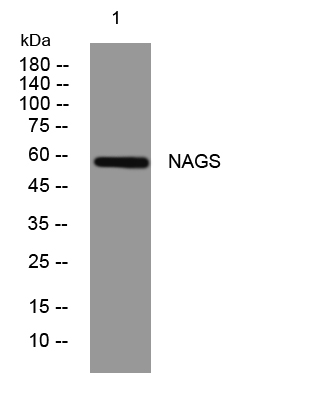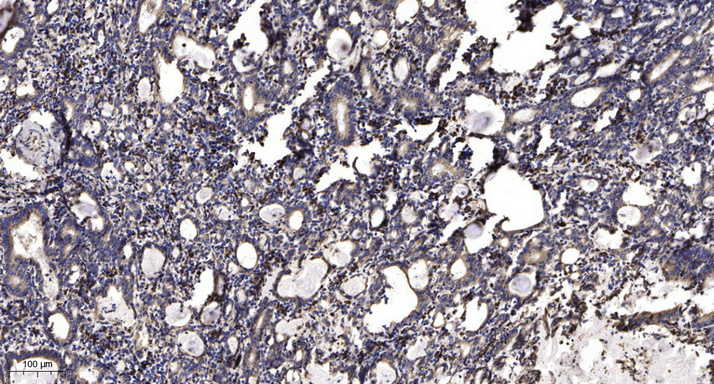NAGS rabbit pAb
- Catalog No.:YT6772
- Applications:WB;IHC
- Reactivity:Human;Mouse
- Target:
- NAGS
- Fields:
- >>Arginine biosynthesis;>>Metabolic pathways;>>2-Oxocarboxylic acid metabolism;>>Biosynthesis of amino acids
- Gene Name:
- NAGS
- Protein Name:
- NAGS
- Human Gene Id:
- 162417
- Human Swiss Prot No:
- Q8N159
- Mouse Gene Id:
- 217214
- Mouse Swiss Prot No:
- Q8R4H7
- Immunogen:
- Synthesized peptide derived from human NAGS AA range: 361-411
- Specificity:
- This antibody detects endogenous levels of NAGS at Human/Mouse
- Formulation:
- Liquid in PBS containing 50% glycerol, 0.5% BSA and 0.02% sodium azide.
- Source:
- Polyclonal, Rabbit,IgG
- Dilution:
- WB 1:500-2000;IHC 1:50-300
- Purification:
- The antibody was affinity-purified from rabbit antiserum by affinity-chromatography using epitope-specific immunogen.
- Concentration:
- 1 mg/ml
- Storage Stability:
- -15°C to -25°C/1 year(Do not lower than -25°C)
- Molecular Weight(Da):
- 59kD
- Background:
- The N-acetylglutamate synthase gene encodes a mitochondrial enzyme that catalyzes the formation of N-acetylglutamate (NAG) from glutamate and acetyl coenzyme-A. NAG is a cofactor of carbamyl phosphate synthetase I (CPSI), the first enzyme of the urea cycle in mammals. This gene may regulate ureagenesis by altering NAG availability and, thereby, CPSI activity. Deficiencies in N-acetylglutamate synthase have been associated with hyperammonemia. [provided by RefSeq, Jul 2008],
- Function:
- catalytic activity:Acetyl-CoA + L-glutamate = CoA + N-acetyl-L-glutamate.,disease:Defects in NAGS are the cause of N-acetylglutamate synthase deficiency (NAGSD) [MIM:237310]. NAGSD is a rare autosomal recessively inherited metabolic disorder leading to severe neonatal or late onset hyperammonemia without increased excretion of orotic acid. Clinical symptoms are somnolence, tachypnea, feeding difficulties, a severe neurologic presentation characterized by uncontrollable movements, developmental delay, visual impairment, failure to thrive and hyperammonemia precipitated by the introduction of high-protein diet or febrile illness.,enzyme regulation:Increased by L-arginine.,function:Plays a role in the regulation of ureagenesis by producing variable amounts of N-acetylglutamate (NAG), thus modulating carbamoylphosphate synthase I (CPSI) activity.,online information:N-acetylglutamate synthase
- Subcellular Location:
- Mitochondrion matrix .
- Expression:
- Highly expressed in the adult liver, kidney and small intestine. Weakly expressed in the fetal liver, lung, pancreas, placenta, heart and brain tissue.
- June 19-2018
- WESTERN IMMUNOBLOTTING PROTOCOL
- June 19-2018
- IMMUNOHISTOCHEMISTRY-PARAFFIN PROTOCOL
- June 19-2018
- IMMUNOFLUORESCENCE PROTOCOL
- September 08-2020
- FLOW-CYTOMEYRT-PROTOCOL
- May 20-2022
- Cell-Based ELISA│解您多样本WB检测之困扰
- July 13-2018
- CELL-BASED-ELISA-PROTOCOL-FOR-ACETYL-PROTEIN
- July 13-2018
- CELL-BASED-ELISA-PROTOCOL-FOR-PHOSPHO-PROTEIN
- July 13-2018
- Antibody-FAQs
- Products Images

- Western blot analysis of lysates from HpeG2 cells, primary antibody was diluted at 1:1000, 4°over night

- Immunohistochemical analysis of paraffin-embedded human Gastric adenocarcinoma. 1, Antibody was diluted at 1:200(4° overnight). 2, Tris-EDTA,pH9.0 was used for antigen retrieval. 3,Secondary antibody was diluted at 1:200(room temperature, 45min).



